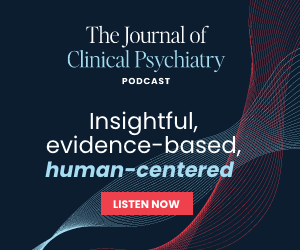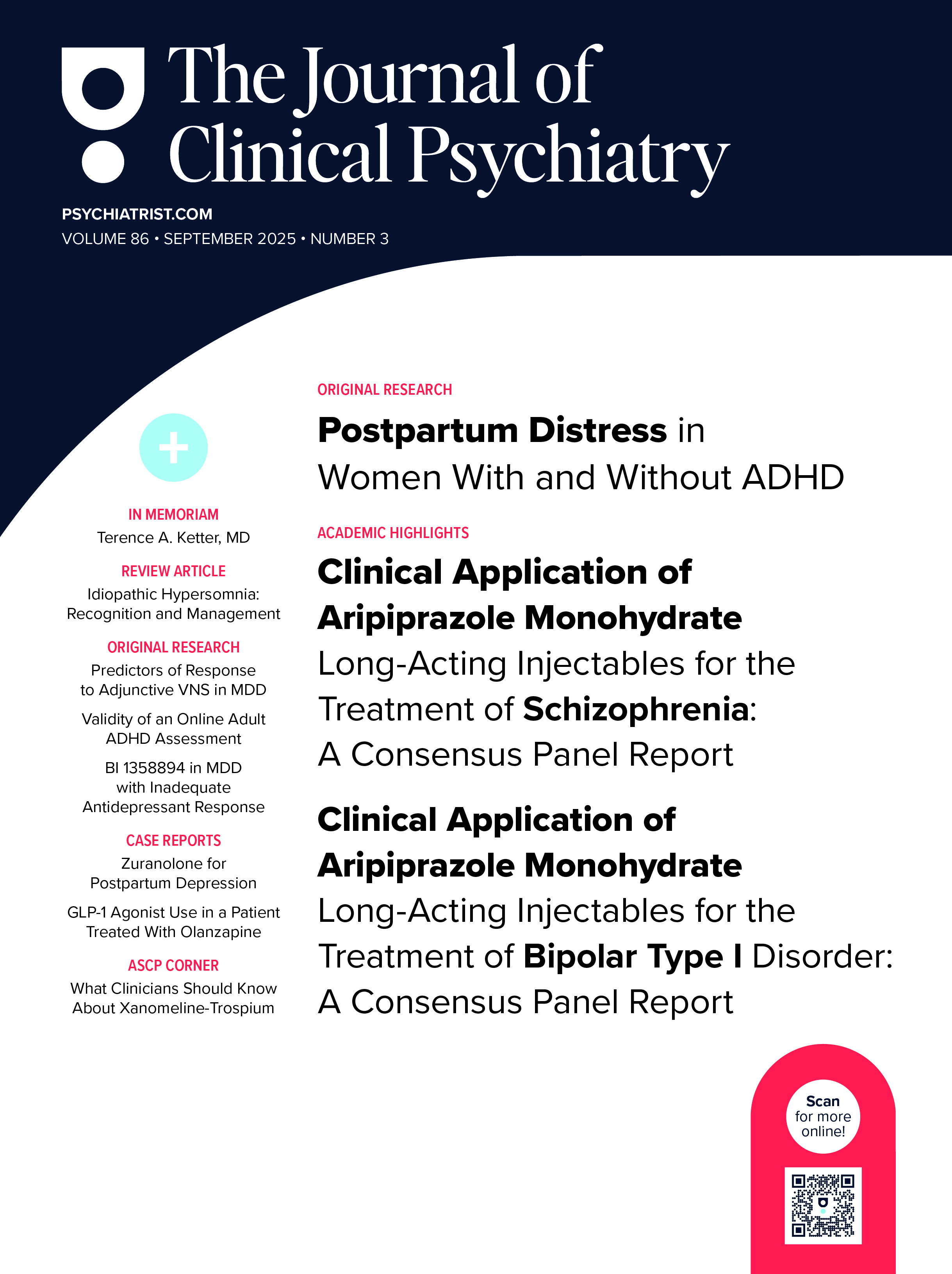
ABSTRACT
Objective: Mood disorders often co-occur with attention-deficit/hyperactive disorder (ADHD), disruptive behavior disorders (DBDs), and aggression. We aimed to determine if polygenic risk scores (PRSs) based on external genome-wide association studies (GWASs) of these disorders could improve genetic identification of mood disorders.
Methods: We combined 6 independent family studies that had genetic data and diagnoses for mood disorders that were made using different editions of the Diagnostic and Statistical Manual of Mental Disorders (DSM). We identified mood disorders, either concurrently or in the future, in participants between 6 and 17 years of age using PRSs calculated using summary statistics of GWASs for ADHD, ADHD with DBD, major depressive disorder (MDD), bipolar disorder (BPD), and aggression to compute PRSs.
Results: In our sample of 485 youths, 356 (73%) developed a subthreshold or full mood disorder and 129 (27%) did not. The cross-validated mean areas under the receiver operating characteristic curve (AUCs) for the 7 models identifying participants with any mood disorder ranged from 0.552 in the base model of age and sex to 0.648 in the base model + all 5 PRSs. When included in the base model individually, the ADHD PRS (OR = 1.65, P < .001), Aggression PRS (OR = 1.27, P = .02), and MDD PRS (OR = 1.23, P = .047) were significantly associated with the development of any mood disorder.
Conclusions: Using PRSs for ADHD, MDD, BPD, DBDs, and aggression, we could modestly identify the presence of mood disorders. These findings extend evidence for transdiagnostic genetic components of psychiatric illness and demonstrate that PRSs calculated using traditional diagnostic boundaries can be useful within a transdiagnostic framework.
Members Only Content
This full article is available exclusively to Professional tier members. Subscribe now to unlock the HTML version and gain unlimited access to our entire library plus all PDFs. If you’re already a subscriber, please log in below to continue reading.
References (43)

- Gore FM, Bloem PJ, Patton GC, et al. Global burden of disease in young people aged 10–24 years: a systematic analysis. Lancet. 2011;377(9783):2093–2102. PubMed CrossRef
- Costello EJ, Copeland W, Cowell A, et al. Service costs of caring for adolescents with mental illness in a rural community, 1993–2000. Am J Psychiatry. 2007;164(1):36–42. PubMed CrossRef
- Kraus C, Kadriu B, Lanzenberger R, et al. Prognosis and improved outcomes in major depression: a review. Focus Am Psychiatr Publ. 2020;18(2):220–235. PubMed CrossRef
- Ghio L, Gotelli S, Marcenaro M, et al. Duration of untreated illness and outcomes in unipolar depression: a systematic review and meta-analysis. J Affect Disord. 2014;152-154:45–51. PubMed CrossRef
- Hung CI, Liu CY, Yang CH. Untreated duration predicted the severity of depression at the two-year follow-up point. PLoS One. 2017;12(9):e0185119. PubMed CrossRef
- Bukh JD, Bock C, Vinberg M, et al. The effect of prolonged duration of untreated depression on antidepressant treatment outcome. J Affect Disord. 2013;145(1):42–48. PubMed CrossRef
- Berk M, Brnabic A, Dodd S, et al. Does stage of illness impact treatment response in bipolar disorder? empirical treatment data and their implication for the staging model and early intervention. Bipolar Disord. 2011;13(1):87–98. PubMed CrossRef
- Biederman J, Newcorn J, Sprich S. Comorbidity in attention deficit hyperactivity disorder. In: Task Force on DSM-IV, ed. Source Book for DSM-IV. American Psychiatric Association; 1990:145–162.
- Neuman RJ, Heath A, Reich W, et al; Madden PAF. Latent class analysis of ADHD and comorbid symptoms in a population sample of adolescent female twins. J Child Psychol Psychiatry. 2001;42(7):933–942. PubMed CrossRef
- Smoller JW, Andreassen OA, Edenberg HJ, et al. Psychiatric genetics and the structure of psychopathology. Mol Psychiatry. 2019;24(3):409–420. PubMed CrossRef
- Anttila V, Bulik-Sullivan B, Finucane HK, et al; Brainstorm Consortium. Analysis of shared heritability in common disorders of the brain. Science. 2018;360(6395):eaap8757. PubMed CrossRef
- Radonjić NV, Hess JL, Rovira P, et al. Structural brain imaging studies offer clues about the effects of the shared genetic etiology among neuropsychiatric disorders. Mol Psychiatry. 2021;26(6):2101–2110. PubMed CrossRef
- Nunnally JC. Psychometric Theory. McGraw Hill; 1978.
- Faraone SV, Biederman J. Do attention deficit hyperactivity disorder and major depression share familial risk factors? J Nerv Ment Dis. 1997;185(9):533–541. PubMed CrossRef
- Nigg JT, Karalunas SL, Gustafsson HC, et al. Evaluating chronic emotional dysregulation and irritability in relation to ADHD and depression genetic risk in children with ADHD. J Child Psychol Psychiatry. 2020;61(2):205–214. PubMed CrossRef
- Demontis D, Walters RK, Martin J, et al; ADHD Working Group of the Psychiatric Genomics Consortium (PGC); Early Lifecourse & Genetic Epidemiology (EAGLE) Consortium; 23andMe Research Team. Discovery of the first genome-wide significant risk loci for attention deficit/hyperactivity disorder. Nat Genet. 2019;51(1):63–75. PubMed CrossRef
- Demontis D, Walters RK, Rajagopal VM, et al; ADHD Working Group of the Psychiatric Genomics Consortium (PGC). Risk variants and polygenic architecture of disruptive behavior disorders in the context of attention-deficit/hyperactivity disorder. Nat Commun. 2021;12(1):576. PubMed CrossRef
- Anney RJ, Lasky-Su J, O’Dúshláine C, et al. Conduct disorder and ADHD: evaluation of conduct problems as a categorical and quantitative trait in the international multicentre ADHD genetics study. Am J Med Genet B Neuropsychiatr Genet. 2008;147B(8):1369–1378. PubMed CrossRef
- Zhang-James Y, Faraone SV. Genetic architecture for human aggression: a study of gene-phenotype relationship in OMIM. Am J Med Genet B Neuropsychiatr Genet. 2016;171(5):641–649. PubMed CrossRef
- Schiweck C, Arteaga-Henriquez G, Aichholzer M, et al. Comorbidity of ADHD and adult bipolar disorder: a systematic review and meta-analysis. Neurosci Biobehav Rev. 2021;124:100–123. PubMed CrossRef
- van Hulzen KJE, Scholz CJ, Franke B, et al; PGC ADHD Working Group; PGC Bipolar Disorder Working Group. Genetic overlap between attention-deficit/hyperactivity disorder and bipolar disorder: evidence from genome-wide association study meta-analysis. Biol Psychiatry. 2017;82(9):634–641. PubMed CrossRef
- Biederman J, Green A, DiSalvo M, et al. Can polygenic risk scores help identify pediatric bipolar spectrum and related disorders? a systematic review. Psychiatry Res. 2021;299:113843. PubMed CrossRef
- Biederman J, Faraone S, Milberger S, et al. A prospective 4-year follow-up study of attention-deficit hyperactivity and related disorders. Arch Gen Psychiatry. 1996;53(5):437–446. PubMed CrossRef
- Biederman J, Monuteaux MC, Mick E, et al. Psychopathology in females with attention-deficit/hyperactivity disorder: a controlled, five-year prospective study. Biol Psychiatry. 2006;60(10):1098–1105. PubMed CrossRef
- Wilens TE, Biederman J, Adamson JJ, et al. Further evidence of an association between adolescent bipolar disorder with smoking and substance use disorders: a controlled study. Drug Alcohol Depend. 2008;95(3):188–198. PubMed CrossRef
- Wozniak J, Faraone SV, Martelon M, et al. Further evidence for robust familiality of pediatric bipolar I disorder: results from a very large controlled family study of pediatric bipolar I disorder and a meta-analysis. J Clin Psychiatry. 2012;73(10):1328–1334. PubMed CrossRef
- Faraone SV, Biederman J, Doyle A, et al. Neuropsychological studies of late onset and subthreshold diagnoses of adult attention-deficit/hyperactivity disorder. Biol Psychiatry. 2006;60(10):1081–1087. PubMed CrossRef
- Faraone SV, Doyle AE, Lasky-Su J, et al. Linkage analysis of attention deficit hyperactivity disorder. Am J Med Genet B Neuropsychiatr Genet. 2008;147B(8):1387–1391. PubMed CrossRef
- Orvaschel H, Puig-Antich J. Schedule for Affective Disorders and Schizophrenia for School-Age Children: Epidemiologic Version. Nova University; 1987.
- Stahl EA, Breen G, Forstner AJ, et al; eQTLGen Consortium; BIOS Consortium; Bipolar Disorder Working Group of the Psychiatric Genomics Consortium. Genome-wide association study identifies 30 loci associated with bipolar disorder. Nat Genet. 2019;51(5):793–803. PubMed CrossRef
- Wray NR, Ripke S, Mattheisen M, et al; eQTLGen; 23andMe; Major Depressive Disorder Working Group of the Psychiatric Genomics Consortium. Genome-wide association analyses identify 44 risk variants and refine the genetic architecture of major depression. Nat Genet. 2018;50(5):668–681. PubMed CrossRef
- Purcell SM, Wray NR, Stone JL, et al; International Schizophrenia Consortium. Common polygenic variation contributes to risk of schizophrenia and bipolar disorder. Nature. 2009;460(7256):748–752. PubMed CrossRef
- Elam KK, Chassin L, Pandika D. Polygenic risk, family cohesion, and adolescent aggression in Mexican American and European American families: developmental pathways to alcohol use. Dev Psychopathol. 2018;30(5):1715–1728. PubMed CrossRef
- Vaudreuil CAH, Faraone SV, Di Salvo M, et al. The morbidity of subthreshold pediatric bipolar disorder: a systematic literature review and meta-analysis. Bipolar Disord. 2019;21(1):16–27. PubMed CrossRef
- Price AL, Patterson NJ, Plenge RM, et al. Principal components analysis corrects for stratification in genome-wide association studies. Nat Genet. 2006;38(8):904–909. PubMed CrossRef
- DeLong ER, DeLong DM, Clarke-Pearson DL. Comparing the areas under two or more correlated receiver operating characteristic curves: a nonparametric approach. Biometrics. 1988;44(3):837–845. PubMed CrossRef
- StataCorp. Stata Statistical Software: Release 16. College Station, Texas: StataCorp LLC; 2019.
- Levitan RD, Zhang CXW, Knight JA, et al. Using precision medicine with a neurodevelopmental perspective to study inflammation and depression. Curr Psychiatry Rep. 2020;22(12):87. PubMed CrossRef
- Muntaner-Mas A, Ortega FB, Femia P, et al. Low cardiorespiratory fitness and obesity for ADHD in childhood and adolescence: a 6-year cohort study. Scand J Med Sci Sports. 2021;31(4):903–913. PubMed CrossRef
- Chen Q, Hartman CA, Kuja-Halkola R, et al. Attention-deficit/hyperactivity disorder and clinically diagnosed obesity in adolescence and young adulthood: a register-based study in Sweden. Psychol Med. 2019;49(11):1841–1849. PubMed CrossRef
- Chen Q, Hartman CA, Haavik J, et al. Common psychiatric and metabolic comorbidity of adult attention-deficit/hyperactivity disorder: a population-based cross-sectional study. PLoS One. 2018;13(9):e0204516. PubMed CrossRef
- Li J, Pan C, Zhang S, et al. Decoding the genomics of abdominal aortic aneurysm. Cell. 2018;174(6):1361–1372.e10. PubMed CrossRef
- Xu M, Tantisira KG, Wu A, et al. Genome wide association study to predict severe asthma exacerbations in children using random forests classifiers. BMC Med Genet. 2011;12(1):90. PubMed CrossRef





